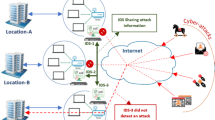Abstract
The prediction of intrusion intention of abnormal information in wireless network can effectively guarantee the security and stability of network. Traditional methods describe the relationship between different types of attacks. When building the model, only the path of the network nodes involved in the current attack behavior is considered, so the vulnerability of the network can not be analyzed in detail. Then, a network attack node path detection model based on attack graph is proposed. Firstly, according to the theory of attack graph, the network attack graph is defined, the right state of attacker is detected, the connection matrix of network is obtained, and the formal description of vulnerability, attack effect and attack premise is obtained. Then, the attack path graph is used to describe the transfer relationship between nodes, map the process of the attack from one host or vulnerability to the next host or vulnerability, and give the shortest path to achieve the attack intention. Further obtain the maximum possibility of intrusion under each attack path of the network, and build a network attack node path detection model based on the detection results. The experimental results show that the proposed model has high accuracy and effectively improves the efficiency of network security analysis.





Similar content being viewed by others
References
Abraham S (2015) A predictive framework for cyber security analytics using attack graphs. Int J Computer Netw Commun 7(1):1–17
Anil A, Singh SR, Sarmah R (2018) Mining heterogeneous terrorist attack network using personalized PageRank. Web Intell Agent Syst 16(1):37–52
Bartos V, Zadnik M, Habib SM et al (2019) Network entity characterization and attack prediction. Future Gener Computer Syst 97:674–686
Bhushan K, Gupta BB (2019) Distributed denial of service (DDoS) attack mitigation in software defined network (SDN)-based cloud computing environment. J Ambient Intell Humaniz Comput 10(5):1985–1997
Fredj BO (2015) A realistic graph-based alert correlation system. Secur Commun Netw 8(15):2477–2493
Hui W, Xinxin RU, Tianwang D et al (2019) Attack profit path prediction algorithm based on NAPG model. J Jilin Univ. https://doi.org/10.13413/j.cnki.jdxblxb.2018404
Jiang Z, Zhao K, Li R et al (2020) PHYAlert: identity spoofing attack detection and prevention for a wireless edge network. J Cloud Comput 9(1):1–13
Liu SC, Liu Y (2016) Network security risk assessment method based on HMM and attack graph model[C]// IEEE/ACIS. Int Conf Softw Eng. https://doi.org/10.1109/SNPD.2016.7515951
Moskal S, Yang SJ, Kuhl ME (2018) Cyber threat assessment via attack scenario simulation using an integrated adversary and network modeling approach. J Def Model Simul 15(1):13–29
Ren T, Liu MM, Xu YJ et al (2018) Prediction of damage results of complex network under grey information attack. J Intell Fuzzy Syst 35(6794):1–16
Rezaei-Ravari M, Sattari-Naeini V (2018) Reliable congestion-aware path prediction mechanism in 2D NoCs based on EFuNN. J Supercomput 1:1–24
Ruban I, Lukova-Chuiko N, Mukhin V et al (2018) The method of hidden terminal transmission of network attack signatures. Int J Computer Netw Inf Secur 10(4):1–9
Salehi M, Karimian J, Jahan MV (2019) A DOS and network probe attack detection based on HMM using fuzzy inference. Int J Computer Netw Inf Secur 11(4):35–42
Tiwari P, Veenadhari S (2019) Data link and network layer attack prevention in DTN mobile ad-hoc network. Int J Computer Sci Eng 7(3):584–590
Wang X, Zhang X (2019) Wireless network attack defense algorithm using deep neural network in internet of things environment. Int J Wirel Inf Netw 26(3):143–151
Wang E, Wang Y, Qu P et al (2018) Effectiveness analysis of complex network edge attack strategy with cost. XI Tong Gong Cheng Yu Dian Zi Ji Shu/syst Eng Electron 40(4):919–926
Wang EK, Wang F, Sun R et al (2019) A new privacy attack network for remote sensing images classification with small training samples. Math Biosci Eng 16(5):4456–4476
Xie B, Peng C, Zhang H et al (2018) Power system state estimation based on network attack node credibility. Yi Qi Yi Biao Xue Bao/Chin J Sci Instrum 39(3):157–166
Xu X, Wang S, Li Y (2018) Identification and predication of network attack patterns in software-defined networking. Peer to Peer Netw Appl 12(1):1–11
Yu W (2019) Convolutional neural network attack on cryptographic circuits[J]. Electron Lett 55(5):246–248
Yu B, Liu Z (2018) Malicious attack-resistant secure localization algorithm for ZigBee network. Dianzi Yu Xinxi Xuebao/J Electron Inf Technol 40(7):1676–1683
Zhong S, Fu Q, Xia K et al (2020) Online model-learning algorithm from samples and trajectories. J Ambient Intell Human Comput 11(2):527–537
Zhou YF, Chen N (2019) The LAP under facility disruptions during early post-earthquake rescue using PSO-GA hybrid algorithm. Fresenius Environ Bull 28(12A):9906–9914
Zhou Y, Yu H, Li Z, Su J, Liu C et al (2020) Robust optimization of a distribution network location-routing problem under carbon trading policies. IEEE Access 8(1):46288–46306
Author information
Authors and Affiliations
Corresponding author
Additional information
Publisher's Note
Springer Nature remains neutral with regard to jurisdictional claims in published maps and institutional affiliations.
Rights and permissions
About this article
Cite this article
Liu, X. A network attack path prediction method using attack graph. J Ambient Intell Human Comput (2020). https://doi.org/10.1007/s12652-020-02206-5
Received:
Accepted:
Published:
DOI: https://doi.org/10.1007/s12652-020-02206-5




